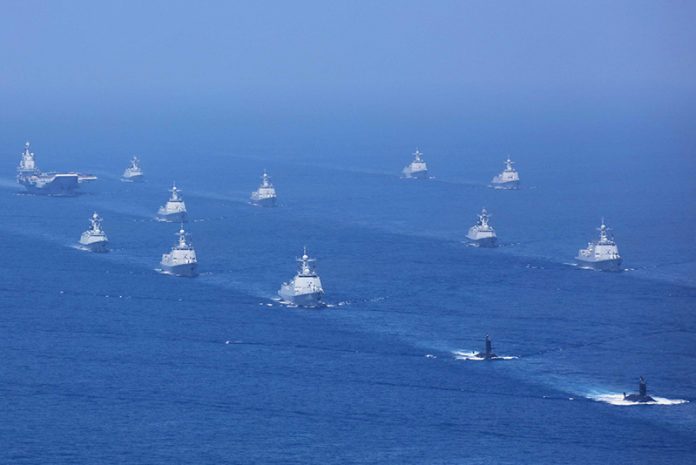The South China Sea has witnessed growing Chinese naval presence, but the People’s Liberal Army Navy (PLA-N) parade on 12 April was of another magnitude. Chinese ambitions to become a leading ‘blue water’ navy and maritime power were on full display, with President Xi Jinping, as chairman of the Central Military Commission, donning camouflage military fatigues.
The parade was the largest ever held by the PLA-N since its creation in 1949. It included the Liaoning aircraft carrier, type 052D destroyers, type 052C destroyers, type 071 amphibious transport dock and type 093 nuclear-powered submarines (two of which carry nuclear-capable intercontinental ballistic missiles). In total, 48 vessels, 76 aircraft and over 10,000 service personnel were reported to be involved. According to articles published on the English language version of the Chinese Central Military Committee website, the PLA-N “displayed its latest equipment and best strength with unprecedented transparency”, thereby sending “subtle messages to the outside world”.
In his remarks, President Xi noted the need to accelerate the development of new types of combat forces and build a modern maritime combat system, and that “the task of building a powerful navy has never been as urgent as it is today”. It was no coincidence that the naval parade coincided with live fire drills in the Taiwan Strait. In doing so, Beijing offered two messages.
The primary message is to Taiwan (Republic of China), whose relationship with the United States under President Trump has strengthened. Beijing sent a clear reminder to Taipei that it will not tolerate any moves toward independence. Since the phone call between President Trump and Taiwan’s President Tsai Ing-wen in 2016, the relationship between Taiwan and the United States has continued to strengthen through decisions in 2017 by the US to sell $1.42 billion in arms to Taiwan, the signing in 2018 of the Taiwan Travel Act into US law thereby allowing bilateral visits of serving US and Taiwanese officials ‘at all levels’, the decision by the US Department of State to allow American manufacturers to sell sensitive technology to Taiwan to help further Taiwan’s indigenous submarine programme, as well as rumours that US marines will stand guard at the new premises of the American representative office in Taipei. These moves have angered Beijing, which has increased pressure on Taiwan’s pro-independence government since it came to power in May 2016. Indeed, Taiwan now counts only 19 diplomatic allies, with the loss of diplomatic recognition from Sao Tome and Principe, Panama and the Dominican Republic since 2016.
Beijing’s displeasure over the current Taiwanese government’s refusal to formally recognise the so-called ‘1992 consensus’ on the One China Policy, has also been increasingly noticeable in official statements by President Xi Jinping. As President Xi noted at the National People’s Congress in March this year, “All manoeuvres and tricks to split the motherland are sure to fail […]. Not one inch of the territory of the great motherland can be carved off from China”. China’s live-fire naval exercises in the Taiwan Strait, held alongside its Naval Parade in the South China Sea, served as a direct warning to Taiwan and follows a steady increase in military exercises around the island.

However, the naval parade also served as a nod to the wider Indo-Pacific region that the growing power of the Chinese navy is a reality they’ll have to accept. The cornerstone of China’s public diplomacy effort as a rising benevolent power has been to promote the ideal of ‘mutual benefit’, ‘common destiny’ and ‘win-win cooperation’. While the Belt and Road Initiative has sought to promote this image of China, Beijing is clearly showing that its path to becoming a super power on the world stage includes the development of a modern military, with a focus on becoming a maritime power. By 2035, China aims to have accomplished military modernisation and by 2050 seeks to have a top-tier military that is capable of winning wars. There has been some discussion on what kind of super power China would like to be – will it want the responsibilities that come along with the title? Time will tell how China’s military forces will be used, but pace at which it continues to address its capability gaps are an indication that President Xi is living up to his statement at the 13th National People’s Congress that Beijing is “resolved to fight the bloody battle against our enemies…with a strong determination to take our place in the world”. In the short-to-medium term, this will mean that China’s priorities will focus on furthering its military modernisation programme to be able to protect its core interests. Those include Taiwan, but they also include positioning China as the regional hegemon in Asia by displacing the United States and dissuading other regional actors from challenging Beijing’s dominance.
The question, however, is whether by showing that Beijing is not just an economic power but a military power, it will create the very obstacles to its own rise that it is currently seeking to overcome. This will depend on two things: whether other countries are up to the task of challenging the notion of Chinese dominance in the region, and how fast China can overcome its own limitations in military capabilities. If it’s accomplishments to-date as shown in the Naval Parade are any indication, Beijing will continue to strive to meet its 2035 and 2050 goals.













